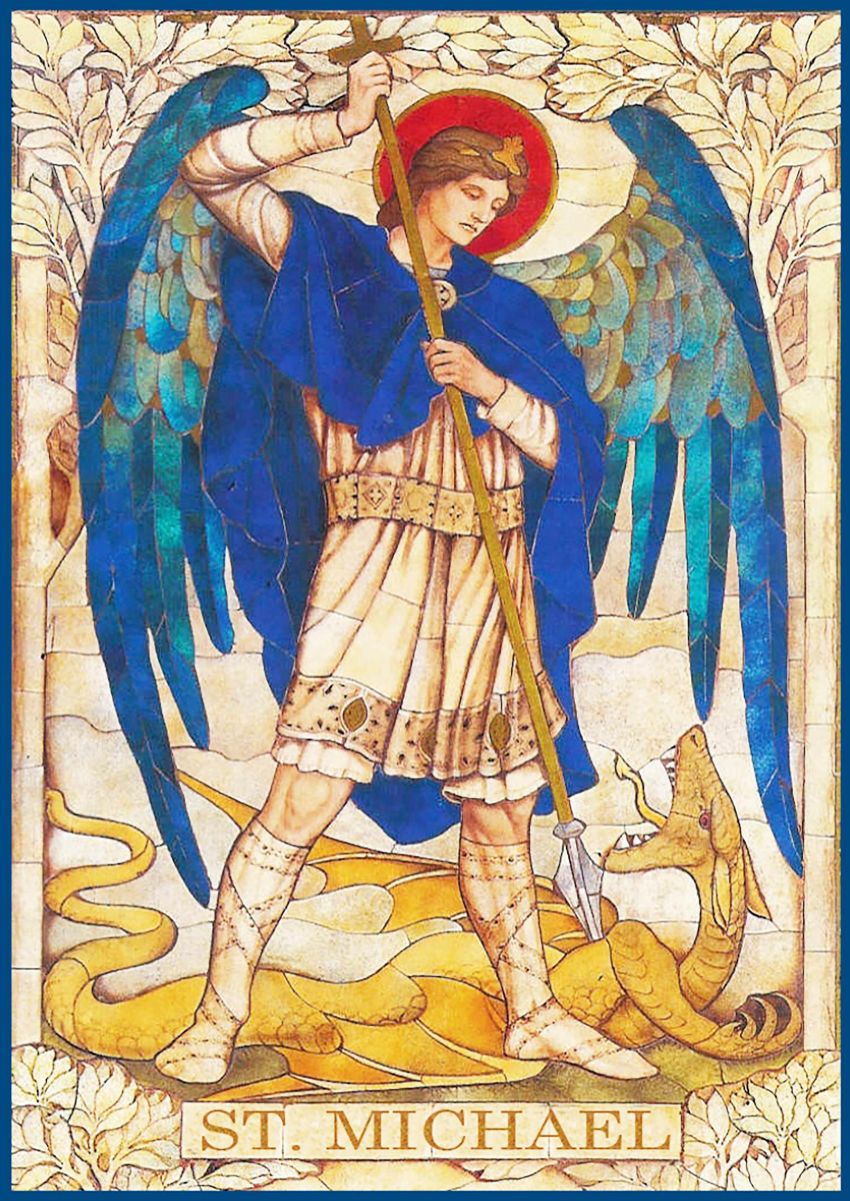St. Michael's Sword

|
Do "ley lines"
exist? Me, I have no idea, and am not sure I understand what a "ley
line" is actually supposed to be. But I have discovered something
possibly interesting about many of the sites at which St. Michael has
appeared to humans, or, at least, sites at which St. Michael is honored
in extraordinary ways. Consider:
About seven and a half miles off the Southwest coast of Ireland is a
very tiny, very craggy, very inhospitable, steep pyramid of an island
called "Skellig Michael." In 60 A.D., Aristobulus of Britannia -- named
as one of "the seventy" (Luke 10) , mentioned in Romans 16:11, ordained
by St. Paul, and the first Bishop of Roman Britan -- ordered that a
hermitage be built on the island to preserve texts brought to Britain
by Joseph Of Arimathea (Matthew 27:57; Mark 15:43; John 19:38). Since
at least 1044, the island has been consecrated to St. Michael --
possibly because of an at least legendary association between the place
and St. Patrick: it was here that St. Patrick is said to have had his
final show-down with the serpents that once plagued Ireland. Sadly, the
place is no longer in Catholic hands -- not since the so called
"Reformation." But it retains its Catholic name.
Off the West coast of Cornwall, England, is another little island
dedicated to St. Michael: St Michael's Mount. Our archangel is said to
have appeared there in A.D. 495, and Benedictines built an abbey there
in his honor. The place very much resembles Mt. St. Michel in Normandy,
the next site on our list.
Mont St. Michel was built to St. Michael's honor off the coast of
Normandy, France because our warrior Saint is said to have appeared
there in 708 to St. Aubert, Bishop of Avranches.
After Normandy, France's Mt. St. Michel comes Sacra di San Michele in
Sant'Ambrogio of Turin, Piedmont, Italy. Originally built in around 983
after an appearance there by St. Michael, this monastery and church sit
atop Monte Pirchiriano, a mountain that is a part of the Italian Alps.
The Benedictines took over the place in the 11th century, and the the
church was rebuilt in the 12th.
Next comes the Sanctuary of San Michele Arcangelo, in Monte
Sant'Angelo,
Puglia, Italy. As I wrote on the page about the Feast of St. Michael,
"[T]he Sanctuary of Monte Sant'Angelo [is] in the province of Foggia,
in northern Apulia, Italy. This basilica is at the site of a cave near
which St. Michael appeared several times to the Bishop of Sipontum in
A.D. 490. Michael told the Bishop that the cave should be consecrated
and that, in return, the nearby town of Sipontum would be saved from
pagan invaders. When the pagans came, St. Michael appeared on top of a
mountain near the cave, brandishing a flaming sword, and the people of
the town were victorious. Pope Gelasius I, who held the Petrine office
from A.D. 492 to 496 built the basilica there, and the cave itself is a
place of healing and pilgrimage."
Then there is the Greek Orthodox Monastery of Taxiarchis Mihail
Panormitis dedicated to St. Michael on the island of Symi, in the
Dodecanese archipelago in Greece. It was originally built in 450, on a
site once dedicated to Apollo, but underwent major restoration in the
18th century. In the church there is a very famous icon -- Archangel
Michael of Panormitis.
Finally, in Mount Carmel in Haifa, Israel is the Carmelite Stella Maris
Monastery which contains the cave in which the prophet Elias (Elijah)
hid (III Kings 19; I Kings 19 in Bibles with Masoretic numbering). For
the life of me, I can't figure out what this monastery has to do with
St. Michael, but it is on every list of sites relevant to this page,
which is about the alleged "Line of St. Michael" -- sometimes
called "St. Michael's Sword."
What is this line, this sword? It turns out that if you plot all of
these sites on a map -- Skellig Michael in Ireland; St. Michael's Mount
in England; Mt. St. Michel in France; Sacra di San Michele in Italy;
San Michele Arcangelo in Italy; Greek Orthodox Monastery of Taxiarchis
Mihail Panormitis in Greece; and Stella Maris monastery in Israel --
they all form a perfect line.
The Italian version of Wikipedia says that the alignment reflects the zodiacal axis which starts
from the north-west from Virgo and ends in
the south-east with Pisces. The English Wikipedia says that "[a]nother
interesting thing is that the Sacred Line is perfectly aligned with the
sunset on the day of the Northern Hemisphere’s Summer Solstice." Hmm,
OK.
So, what is the meaning of it all? Could be nothing. Could be
something. I lean toward the former since I don't understand why that
last monastery is included, and because it ignores other relevant
sites, like the Castel Sant'Angelo in Rome, or Domrémy, France where
St. Joan had her visions of St. Michael, or Monte Sant'Angelo grotto in
Puglia, Italy, the oldest shrine dedicated to St. Michael. But it's a
very pretty
idea
that these sites exist where they do because of some higher planning,
by God's positive will, isn't it? And because this idea is out there in
the Catholic world, I
thought I should tell you about it.
|
|
 Back to the Feast of St.
Michael Back to the Feast of St.
Michael
 Back to Seasonal Customs Back to Seasonal Customs
 Back to Being Catholic Back to Being Catholic
 Index Index
|

